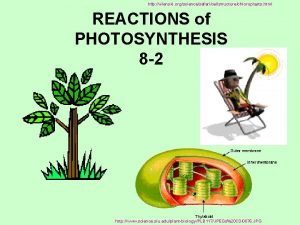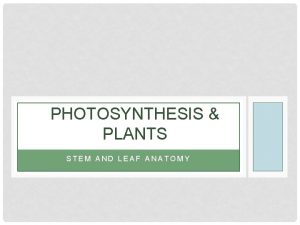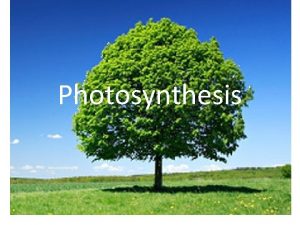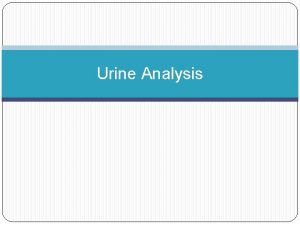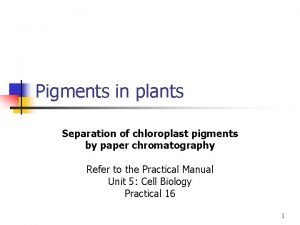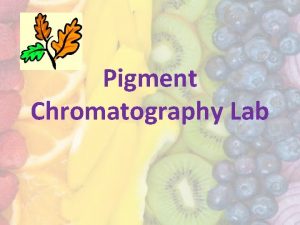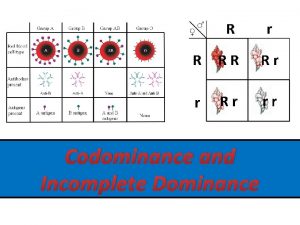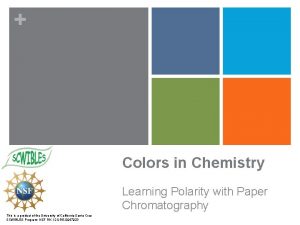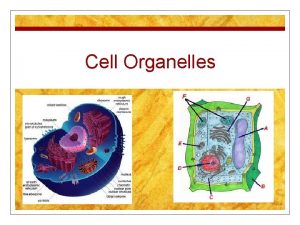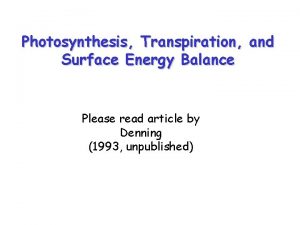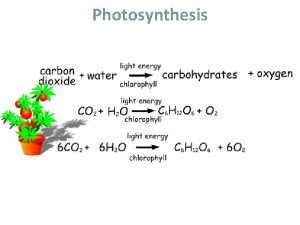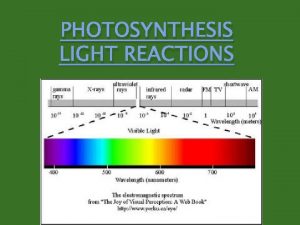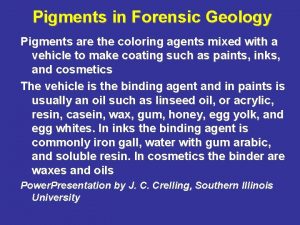Light and Pigments n Photosynthesis also requires light















- Slides: 15

Light and Pigments n Photosynthesis also requires light catching pigments n These photosynthetic pigments are designed to capture the energy from light that is in a specific range of wavelengths

Most common pigment is chlorophyll n Other pigments exist in most plants to capture energy in other wavelengths

Other pigments… n xanthophyll is yellow in color, but is hidden by the green in chlorophyll n beta carotene is orange n chlorophyll gets broken down when the temperature goes down, so other pigments can be seen in the autumn leaf colors

The Reactions of Photosynthesis Inside a chloroplast n Thylakoids – membrane sacs that contain clusters of pigment molecules called photosystems n Grana – stack of thylakoids n Stroma – area outside thylakoids

Light dependent reactions happen inside thylakoids; makes sense, that’s where the photosynthetic pigments are n Light independent reactions happen in the stroma; they are not in the way of the light-dependent reactions n

NADPH n n The process of capturing sunlight results in the formation of high energy electrons (electrons that have jumped to another level; they will give off lots of energy on their way back towards the nucleus of the atom) These high energy electrons require special carrier molecules

NADP+ is a carrier molecule n nicotinamide adenine dinucleotide phosphate accepts a pair of high energy electrons along with a hydrogen ion: H+ creates NADPH – carries the high energy electrons elsewhere in the cell, so there energy can be used to drive other reactions

Light-dependent reactions n require light + n turn ADP and NADP into high energy carriers ATP and NADPH

How does it work? n Light is absorbed by pigments in Photosystem II (discovered after Photosystem I) n Absorbed light increases energy in electrons which are passed on to the electron transport chain n New electrons (to replace the ones the chlorophyll passed on) come from water

High-energy electrons travel from Photosystem II to Photosystem I on the e- transport chain; drives the transport of H+ across the membrane of the thylakoid n Photo. I reenergizes high energy electrons & transfers them to + NADP which becomes NADPH + after picking up H n

n Process creates a charge difference across the thylakoid membranes; restoring the charge balance drives ATP creation n ATP synthase helps with facilitated diffusion of hydrogen ions, but uses their passage to create ATP

The Calvin Cycle n ATP & NADPH are not stable enough to store energy for a long time n The Calvin Cycle converts less stable, high energy molecules into high energy sugars n Calvin cycle is light-independent

How does it work? a. six carbon dioxides enter cycle b. combine with six 5 -carbon molecules which split creating twelve 3 carbon molecules c. 3 carbon molecules are then converted to high energy form using the energy from ATP and NADPH

How does it work? (cont. ) d. 2 of the twelve 3 -carbon compounds are converted to similar molecules and combined to form a 6 -carbon sugar e. The remaining ten 3 -carbon compounds are recombined into 5 carbon compounds and re-enter the cycle

n Plants use 6 -carbon sugars for energy for growth and repair, and to construct complex carbohydrates like cellulose
 Plants gather energy with light-absorbing pigments called *
Plants gather energy with light-absorbing pigments called * Zea mays leaf cross section labeled
Zea mays leaf cross section labeled Photosynthesis requires
Photosynthesis requires Principle of fouchet test
Principle of fouchet test Surface treated pigments
Surface treated pigments Spinach rf values
Spinach rf values Plant pigments chart
Plant pigments chart Leaf pigments
Leaf pigments Co dominance with example
Co dominance with example Polarity color
Polarity color This organelle contains pigments of all colors except green
This organelle contains pigments of all colors except green The primary pigment colors are ____.
The primary pigment colors are ____. Structure of chlorophyll
Structure of chlorophyll Light light light chapter 23
Light light light chapter 23 Light light light chapter 22
Light light light chapter 22 Chapter 22
Chapter 22
